While most eyes are focused on the volleyball court and the high level international competition taking place, one often times will find themselves singing along to a pop song playing in the background between points or during timeouts.
At tournaments like the women’s Volleyball Nations League currently going on in Lincoln, Nebraska, the music and jingles for various feats during the match are hard to miss.
The environment is planned to a T, with the crowd learning chants such as Monster Block, Ace-Ace-Ace, Super Spike, and more, before the match even begins. Everything has its time and place.
Running the entertainment portion of the show, keeping the crowd involved and cueing all of that action is one key figure, although many in the building probably haven’t given him much thought.
Allow us to introduce to DJ Ray.
Ray Gooden is a familiar name in volleyball circles. He’s been around the game for many years, dating back to his playing days at Ohio State, where he was a three-time All-Big Ten Conference club performer. For the last 16 years, he’s been roaming the sidelines as the head coach at Northern Illinois in DeKalb, Illinois, where he has led the Huskies to three Mid-American Conference championships and two NCAA berths, while putting together a 297-212 record and earning himself five MAC Coach of the Year titles.
He’s also had coaching stints at Loyola Chicago (1997-2001), Lewis (1997), Northwestern (1996) and Thomas More (men’s head coach, women’s assistant, 1994-96).
And those familiar with the USA Volleyball High Performance program probably know the jovial coach as well. He’s been involved with High Performance for many years, taking several overseas coaching trips: four to Europe, two to Japan and also making stops in Argentina, Guatemala and Brazil. He was also a court coach and evaluator at U.S. National Team tryouts in Colorado Springs and has been a coach at the National Collegiate Team tryouts.
He certainly has made a name for himself on the sidelines, but VolleyMob wanted to delve into the man you may not know, the one keeping the crowd singing along, dancing and preventing the silence at major international volleyball events around the country.
We sat down with DJ Ray to find out how he got started working in one of the most fun gigs at the venue, to get his take on the music and the volleyball and much more.
We did a little research and found a story from 2008 that somebody did on you and your deejaying. According to that, this all kind of started with you and house parties? The whole music thing, how did it happen for you?
Ray Gooden: So, I’m from a suburb north of Chicago, Evanston, right where Northwestern is; I lived about a mile or two from Northwestern. First of all, house parties were big back then, we were young, and we had parties in basements, and a lot of folks deejayed,. I know at least 30-40 people from my high school who deejayed. From ages 55 down to who knows now. So, in high school I hooked up with some guys, they had some equipment, they let me play. From a distance I always checked it out, I thought it was really cool.
As I was older and got more involved, we played more parties at Northwestern when I was in high school, like their fraternity parties and other house parties. Went to college, and every time I thought I was not good anymore I kept doin’ it. I thought I was done in high school, sold my part of the equipment, went to college at Ohio State, deejayed at different bars and clubs and places around town.
Graduated, thought I was done, deejayed some more in Cincinnati, where I had my first job. Same thing, moved up to Northwestern, deejayed in the city for a while, and I’ve just been doing it since ’86. I don’t know if I consider myself to be a great DJ, a real one… There’s guys I know who go on tours with, like, stars, you know. Rap stars, and other groups. But it’s just kinda been my thing.
So, was it a business back then, or was it something fun you did to hang out with your friends?
It’s always been like just a cool thing. You know, as you get older, you become more professional. You don’t know what you don’t know, but it was always like hey, play a party and make some money. Work at a bar, get drinks, maybe get some money on the side. It was never like, okay I was gonna be a quote “professional DJ.” It’s just been a really big passion for me. Some people like to read, I like to play music.
What do you love about deejaying?
I just love making people feel good, honestly, that’s always been my thing. Whether it’s my days of being a setter, always trying to make hitters feel happy, to coaching, where I am trying to help kids reach their goals.
Music is always a thing. You always connect with music, whether it’s when you’re really young with nursery rhymes, to different parts of your life, different songs bring you back to different phases in your life. I just love it. I try to make people feel as comfortable or as good as possible for as long as I can.
You have travelled all over the world with volleyball, and each environment is different. Have you taken things from those? How does the American environment differ from some of the ones you’ve been in around the world?
I think the American volleyball environment is still to be determined. Here in Nebraska, everyone just assumes it’s going to be like a Nebraska volleyball match as far as the vibe and the energy. It’s cool because they’re knowledgeable, just like Hawaii’s fans are, so they appreciate the volleyball game. I don’t know what they do about the music.
Other places I’ve gone, like I’ve been to Japanese pro leagues awhile before, there’s so much entertainment going on, whether it’s the dancers or this or that, different cheers that the fans have. Other places in Euro, there’s this energy, so you kind of take it from all different parts. And there’s also the American part too, where you go to arenas. You go to basketball games, there’s one vibe, you go to a soccer or football game and there’s a different vibe, so just trying to pull from different parts to help here, for this event.
Obviously you’re playing a lot of throwback stuff, cause it’s crowd friendly, but what are your favorite tunes to spin, what’s on your playlist? Both to play in a venue and also for your personal.
I’m older, so I’m okay with 90s and stuff, I’m okay with current stuff. 90’s hip-hop always seems to be pretty safe for me. I’m from Chicago so I love house music. I also have Jamaican roots so I love reggae, those are my staples. But I love all types, I think the fun of this is being able to play just a bunch of types of music.
Jamie (Davis), the (USA Volleyball) CEO wants music that people can sing along to, not necessarily to have a club environment. So I’m catering it to that. When I play in Chicago (for the men’s Volleyball Nations League), it might be a little different, but at least in this situation, that’s what they’re asking me to do.
You deejay a lot of the men’s matches for USA Volleyball. Do you play stuff depending on the crowd, or more so what you like? What do you do to make people rock out?
A little bit of both. It’s just a feel. On Monday I was here for some of the practices, and I actually deejayed for the national team while they were practicing. They asked me what kind of songs I liked, and I listened to Italy and this listen to a lot of reggaetón and things along those lines, so you kind of get a feel for what world music is. A lot of it right now has an island-y kind of reggaeton Latin pop kind of vibe, so I’ve been doing that. In Chicago, it could have more of an upbeat feel, just because it’s an urban area and they are more accustomed to the pro setting. There’s also gonna be more foreign viewers there too. The last time the USA national team played Poland in Chicago, there were a lot of Poland fans there. It has always been that way. There’s always a strong contingent of Iranian, Italian, you name it. So I feel like it is going to have a more upbeat flare to it.
You’ve watched a lot of these players come up through the ranks in high performance and you’ve watched the national team try out and college national teams, do you remember watching any of these girls play throughout the years? Obviously you’ve probably coached against some of them, too.
Yeah, I’ve seen a fair amount of them at different points. I think the coolest thing for me to see is just their evolution. When you get to this level, they’re professionals. The feel is different, the vibe is different, the approach is different. They’re still a team but in the same sense they ‘re fighting for their livelihood, and so, just to watch each player and how he or she approaches the professional aspect of it is fascinating to me, because I know what those players have done at some point in the past. Some of the foreign players I don’t know, but it still cool to see what their dynamics are like.
But, from when they’re younger players, if I happen to see them, to when they’re older, to see how they’ve evolved over a period of time, as well, is cool.
Do you remember any of them in particular, coaching them or against them?
The Chicago kids I know: Kelly Murphy, Kelsey Robinson, etc. It’s been cool to see those guys play. When Murphy was at Florida, just to see what she was able to do…
Foluke (Akinradewo) I’ve seen her do amazing things, not playing directly against them but seeing what they’ve been able to do. Carli Lloyd, it was cool to see her play, cause she set for Cal, I always thought she just had a great presence about her, how she’s able to win, and now to finally see her get some run.
Micha Hancock, when she played for Penn State, because she was just different, another Midwest kid from Oklahoma. With her serve coming from her left side and just being so athletic and physical, but at that time she was after Alisha Glass, those were the kind of kids they had there when Penn State was doing their thing.
(Justine) Wong-Orantes (Nebraska), just recently seeing her winning a national championship and then seeing her get a chance to do some things on the national team, that part’s pretty cool. Annie Drews (Purdue), she was kind of an unknown, she had a good life, but for her to come on, especially when there was talk of Karsta Lowe being the big person, and here’s this other lefty who has come in and does some really nice things, especially with how big she is. Michelle Bartsch, being a Big Ten kid, just to see how she’s evolved, she moved to the pin and has done some nice things. It’s nice to see these guys, I don’t know all the stats, but it’s nice to see how they’ve evolved over a period of time.
You have been Europe several times, you have been to Asia and many more with high performance, with your teams, etc. What is your favorite place that volleyball has taken you?
Japan and Hawaii. Hawaii, just every time I’ve been there the vibe is great. Our NIU (Northern Illinois) team went there two years ago. We’re a mid-major so we’re doing our thing, we had 6,000 there, which is okay for those guys, but the crowd was so supportive, so happy, so appreciative of us being there, that was a neat thing for our kids. When I was a coach atLoyola for the men’s team, we played there. At that time, we were one of the few teams who had beat them on opening night. They had about 8,000, we did the luau with the booster club. Just the cool thing was walking on Waikiki beach and people knowing “hey you’re playing Hawaii tonight, you’re this team, you’re that team, you’re from Chicago” that part was really fun.
The Japanese thing was just incredible because we were pro. We’re on a bus with pro players. aAguy by the name of (Chieko) Nakanichi, played the same time as Karch (Kiraly), those two probably were the best players in the world at that time. I had a chance to trade jerseys with him; he was the assistant coach when I was there helping out as an advisor. And just to see his presence, where he was the Michael Jordan of volleyball in that area. So it was neat to see what a nice person he was. Those are the two biggest spots I can think of.
The high performance pipeline, which you have worked with quite a bit, is how a lot of these girls get to this stage; do you have any cool stories about that?
I haven’t coached any of these guys, but there are kids coming up who I hope will get a chance, I don’t know. I pray they can make it there. I remember them as seventh graders, eighth graders, freshmen, and they are cute, I won’t say little kids cause they’re 6-5 or 6-6, but they’re just sponges. They don’t know what they don’t know, but they’re so appreciative of it. And then you see them kind of make youth national team or maybe JNT or some of those other things, and that part’s fun.
I coached a college national team one year, and Paige Tapp (Minnesota) was on that team, and it was cool. From there she made the European team or one of the traveling teams, and now she’s in the mix with Team USA, and that’s a cool story because who knows. I think she’s a kid where you look at the metrics, it’s not like she’s this right away, but when you see her play and how she interacts and what she is able to do, she’s doing amazing things. That’s just one player who I had a chance to run across. So all of those things have been really cool to see how people have evolved.
Are there any cool places that deejaying has taken you?
This environment is pretty sweet, I am not gonna lie. One of my coolest stories is when I was doing it for World League in Chicago one of the last times … Sometimes it’s about if you’re lucky, you catch the right things at the right times. There was a challenge in the match, and I had been messing around with some different things. Frozen the movie had just come through, and I played Let It Go. The challenge was a long one, so nearly the entire song played. It at least got to the chorus and the whole crowd’s started singing that, and that part was neat. That was one of those hair-raising moments for me. That was pretty fun and that is one we talk about that still to this day. I’ve been so lucky. I love coaching, I would much rather people know me as a coach, but whatever can get me as close to USA as I can, I’ll do it.
Looking back, you started as a volleyball player at Ohio State, earned some accolades there. As you’ve watched the game, how have things changed?
It’s bigger, stronger, and faster. It’s way more eye appealing to the fan, because when I was playing it was side-out volleyball. And so, you wanted to play a three hour match if you’re a player or a coach, because that’s what it was, that was good volleyball. But the fans didn’t appreciate it, they didn’t know when the games ended, or how points were scored. Now they know that every play is a point and you play to 25, so the games are more intense. Like I said, everybody is just so much bigger. You see kids from Poland that are 6-7 and they look the part. They don’t look awkward, they are just big beautiful women and that is awesome. There are guys who are seven feet, they attack the ball so much higher. Guys are touching over 12 feet. People are serving the ball at 70 mph and spiking it at that same amount. It’s just fun to see that level of volleyball played that way. There’s no way in hell I could come close to it now. But I’m really glad I had the chance to play when I did. And now I am really glad I am a part of it the way I am.
As you watch the action, do you take stuff back from these international competitions and show your team and bring it back to NIU?
For sure. I have a much better chance during practices to see how it. I would much rather see how they train it. The training part is how you build and get to the point where you can show it when the lights come on. It was really important to take some video, take some clips and throw it to GroupMe for the team, back to our staff. There are all different parts to it. We have fun, they have fun. We work, they work. It’s a matter of how long you can do that and how consistently you can do it, that’s what it comes down to.
I was talking with Dave Shondell (Purdue) yesterday about setters. And he said ‘Maybe they don’t really care about having tall setters because there are not a lot of tall setters that are around playing,’ whereas he’s had some history with good setters that had good size: (Jaclyn) Hart, (Ashley) Evans, (Val) Nichols, (Renata) Dargan, to name a few. There were good size kids who eventually learned how to be a force at the net. Setting is about helping your team find success, that’s the biggest thing.
The more you can put yourself in a spot to be successful, the better it is. So, that is the part that I try to take with the kids. You don’t have to be a certain type of thing or the best that there is, you just have to be the best of you that you can be.
- DJ Ray Gooden
- DJ Ray Gooden
- DJ Ray Gooden
- DJ Ray Gooden
- DJ Ray Gooden
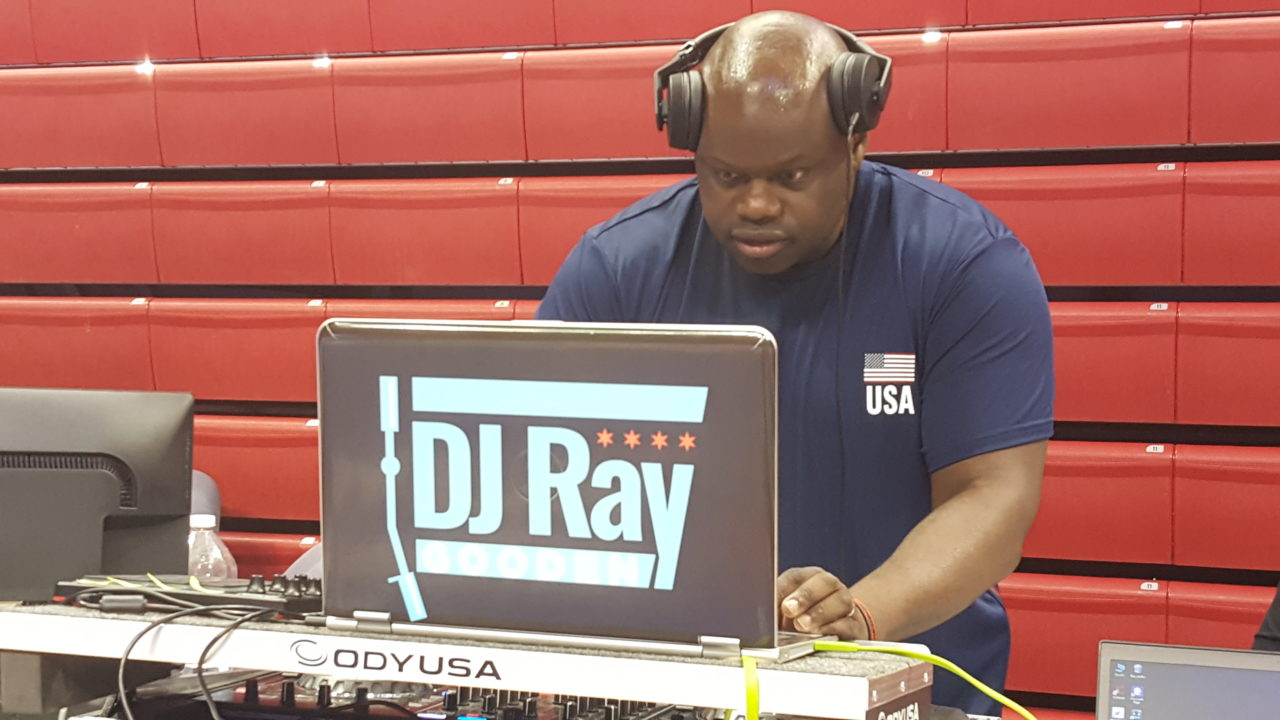
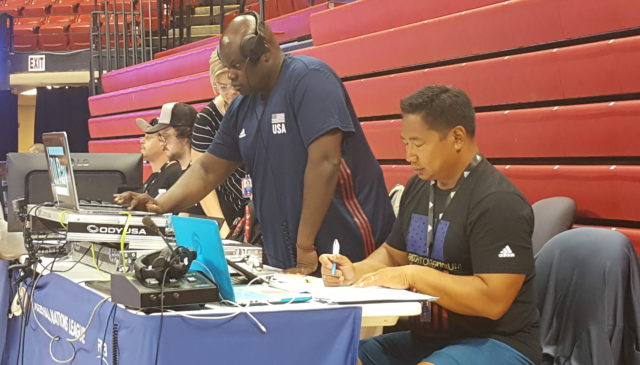
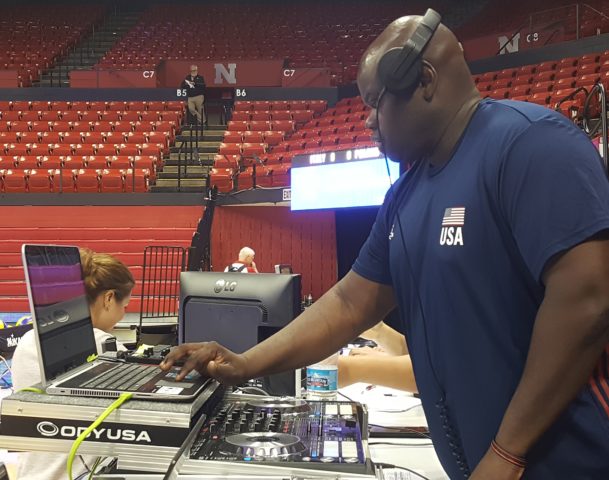
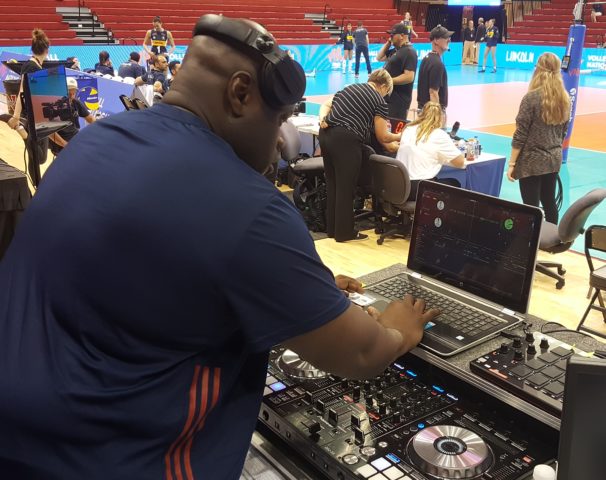
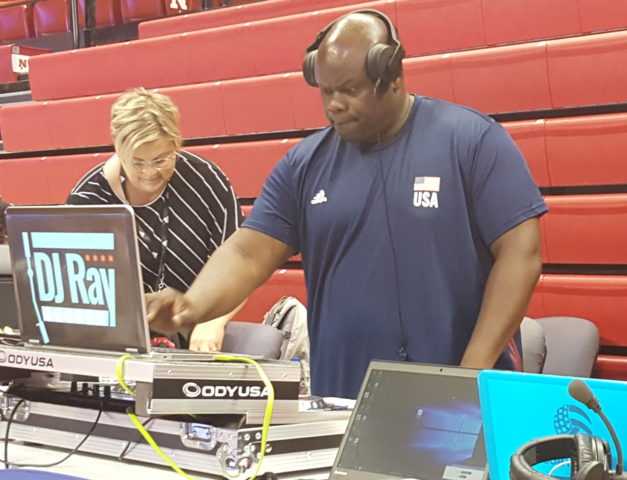

Leave a Reply